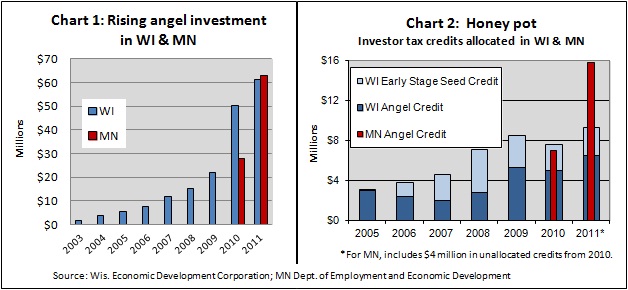With a strong desire to spur job growth, states are eager to nurture young, entrepreneurial firms in hopes that they will develop into booming companies. And you might say the angels have been answering.
Angel investment groups have been popping up across Minnesota and Wisconsin. These are groups of high net worth individuals who seek investment opportunities, often in local or regional businesses. While other investment markets have been fairly static since the recession—and possibly because of it—angel investment groups in Wisconsin and Minnesota have been busy.
Last year, angel investors in Wisconsin doled out $61 million to needy startup firms, and the state has seen a heady increase in total (measured) angel investment since the recession (see Chart 1). Since 2005, the state has seen angel investment groups expand from a small handful to 24 today, sprinkled across the state, including six in the fairly sparsely populated northern and northwestern part of the state located in the Ninth District.

Many attribute that growth to the presence of tax incentives. Wisconsin was an early adopter of tax credits for investors who put their money into very young companies. The state has two such programs, initiated in 2005: an angel tax credit, which allows an accredited investor to offset up to 25 percent of an investment, and a similar program for so-called early-stage seed credit, which is considered the next financial step for a firm after angel investment, but before more sizable venture capital. Investor tax credits in the state topped $9 million for the first time last year (see Chart 2).
The net benefits of such tax credit programs are less obvious than recent activity might suggest. While data imply that tax credits have generated more angel investment, it’s unknown how much angel-like investment was occurring before tax credits and formal angel organizations came around, and how it would have evolved without tax credits. And it shouldn’t be surprising that investors are taking advantage of free money to cushion their risk-taking.
Still, angel activity across the border was enough to convince Minnesota lawmakers in 2010 to create a similar angel tax credit modeled after the cheesehead version, with annual program caps of $12 million in credits. The program wasn’t launched until July of that year, yet investors claimed $7 million in tax credits, and almost $16 million last year (thanks also to $4 million of unallocated credits from the previous year that were rolled over). The state saw $63 million in angel investments in 113 companies last year, which topped Wisconsin.
Not to be outdone, Wisconsin lawmakers greatly expanded their state’s investor tax credit program, allowing the program to allocate up to $40.5 million in tax credits per year, split between angel and early-stage seed investors.
Ron Wirtz is a Minneapolis Fed regional outreach director. Ron tracks current business conditions, with a focus on employment and wages, construction, real estate, consumer spending, and tourism. In this role, he networks with businesses in the Bank’s six-state region and gives frequent speeches on economic conditions. Follow him on Twitter @RonWirtz.





